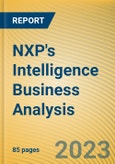In 2022, NXP’s revenue jumped by 19.4% on the previous year to USD13.205 billion, 52% of which was from the Automotive; its net income hit USD2.833 billion, soaring by 48.6%. Despite a good growth, NXP was still positioned second in the industry.
NXP S32 Automotive Platform is designed for autonomous driving, involving the perception, decision and actuation. Among NXP's main ADAS chips, S32R is used for radars, S32A for L3~L5 CPUs, S32V for visual processing, S32G for automotive gateways, S32Z/S32E for real-time processing and power domain controller systems, and S32K for small domain controllers and small sub-nodes.
NXP once worked hard on S32V vision processor and BlueBox ADAS domain controller, but the result was not as expected. By contrast, it succeeded in S32R and S32G.
NXP has gambled on 4D imaging radar and network processor since 2022.
NXP has established a solid foothold in automotive radars for more than 20 years. By 2022, it had launched six generations of radar chips, and has transitioned to RFCMOS as early as the fourth generation. NXP has a leading position in the automotive radar market, offering radar technology to the top 20 automotive OEMs in the world.In early 2022, NXP released the industry’s first dedicated 16nm imaging radar processor, the NXP S32R45, which is also the flagship of NXP’s 6th generation automotive radar chipset family. Additionally, the new NXP S32R41 was introduced to extend 4D imaging radar’s benefits to a much larger number of vehicles including high-end cars, vehicles used for mobility services, and mainstream passenger cars. Together these processors serve the L2+ through L5 autonomy sectors, enabling 4D imaging radar for 360-degree surround sensing.
Radar developers such as Hawkeye and Hasco have developed 4D imaging radars based on NXP S32R45.
Based on NXP S32R45, Hasco has developed 4-chip cascaded imaging radar, with a detection range of 350 meters, 1° horizontal resolution, 2° pitch resolution and ±75° FOV, covering more blind spots. Hasco has a high expectation of the prospect that 4D radar will completely replace conventional ordinary radars in the future. LRR30, Hasco’s 4D radar, can output 1,024 4D point clouds and track up to 64 objects. It is one of the first imaging radar sensors to be production-ready in the market. The LRR40 being developed by Hasco can output up to 3,072 4D point clouds and track 128 objects.The layout in vehicle intelligence in recent year reveals that NXP focuses on deploying radar chips and network processors.
NXP's Thinking on Intelligent Transformation of the Automotive Industry
NXP believes that the automotive industry is building a new triangle value chain. OEMs are mainly responsible for architecture definition and system integration. To this end, they need basic technologies and chip platforms from semiconductor companies, as well as hardware and software integration and software actuation provided by Tier 1 suppliers. NXP aims to gradually step in the triangle value chain as a technical partner. That is to say, a technology company like NXP should have a team that serves Tier 1 suppliers, and another team targeting OEMs. Therefore, in recent years, NXP has been increasing the number of system engineers and software engineers to enhance its complete system-level solutions. In terms of products, NXP is transforming into a chip supplier, that is, it is integrating more software on the basis of chips. NXP’s software engineers have outnumbered hardware engineers. NXP continues system-level investments, in a bid to deeply understand how the automotive architecture develops and evolves.Obviously, other automotive chip vendors such as Horizon Robotics are following suit, making the chip toolchain and grouped algorithms as perfect as possible to reduce the chip introduction workload for OEMs and Tier1 suppliers.
The automotive industry is heading towards software-defined vehicles, and it requires brand-new automotive software development methods to handle ECU integration, data-driven automotive services, secure cloud connection and service-oriented architectures. Automakers and Tier1 suppliers are confronted with new challenges in multi-tenancy (one MPU supports multiple virtual MCUs), network management, cloud services, functional safety and advanced safety technology. This makes it extremely difficult for automakers and Tier1 suppliers to introduce automotive intelligent chips.
NXP’s S32G Vehicle Integration Platform (GoldVIP) provides a reference vehicle integration platform that accelerates S32G hardware evaluation, software development and rapid prototyping efforts. NXP helps address these challenges with GoldVIP’s pre-integrated software, including from partners Airbiquity, Amazon Web Services, Argus Cyber Security and Elektrobit.
GoldVIP has integrated the following software:
- Airbiquity OTAmatic client (for OTA updates)
- AWS IoT Greengrass V2 edge runtime (for secure cloud services)
- Elektrobit tresos AUTOSAR Classic Platform
- Argus Cyber Security Intrusion Detection and Prevention System
This product will be delivered within 3-5 business days.
Table of Contents
Companies Mentioned
- NXP








